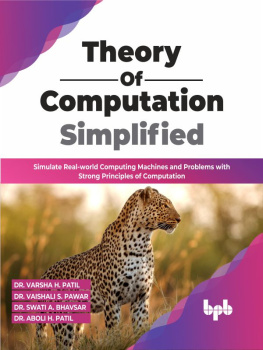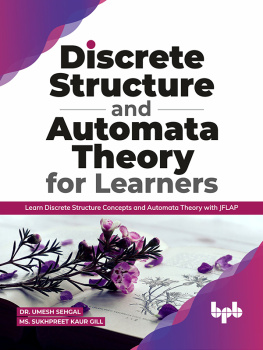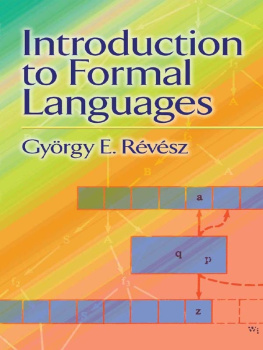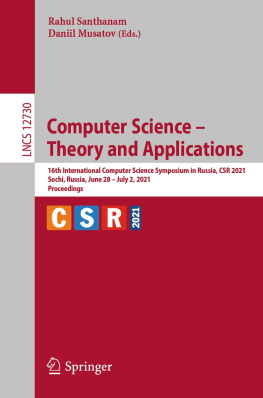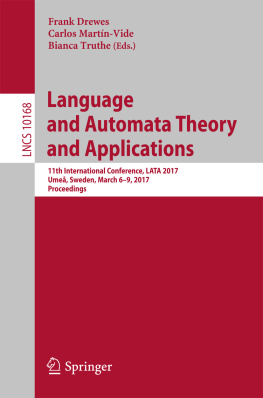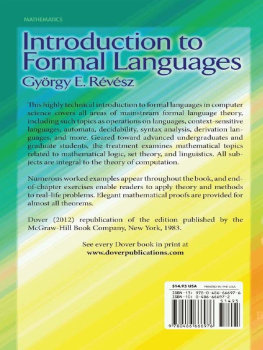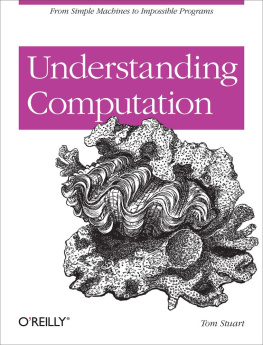Władysław Homenda - Automata Theory and Formal Languages
Here you can read online Władysław Homenda - Automata Theory and Formal Languages full text of the book (entire story) in english for free. Download pdf and epub, get meaning, cover and reviews about this ebook. year: 2022, publisher: De Gruyter, genre: Children. Description of the work, (preface) as well as reviews are available. Best literature library LitArk.com created for fans of good reading and offers a wide selection of genres:
Romance novel
Science fiction
Adventure
Detective
Science
History
Home and family
Prose
Art
Politics
Computer
Non-fiction
Religion
Business
Children
Humor
Choose a favorite category and find really read worthwhile books. Enjoy immersion in the world of imagination, feel the emotions of the characters or learn something new for yourself, make an fascinating discovery.

- Book:Automata Theory and Formal Languages
- Author:
- Publisher:De Gruyter
- Genre:
- Year:2022
- Rating:3 / 5
- Favourites:Add to favourites
- Your mark:
- 60
- 1
- 2
- 3
- 4
- 5
Automata Theory and Formal Languages: summary, description and annotation
We offer to read an annotation, description, summary or preface (depends on what the author of the book "Automata Theory and Formal Languages" wrote himself). If you haven't found the necessary information about the book — write in the comments, we will try to find it.
Automata Theory and Formal Languages — read online for free the complete book (whole text) full work
Below is the text of the book, divided by pages. System saving the place of the last page read, allows you to conveniently read the book "Automata Theory and Formal Languages" online for free, without having to search again every time where you left off. Put a bookmark, and you can go to the page where you finished reading at any time.
Font size:
Interval:
Bookmark:
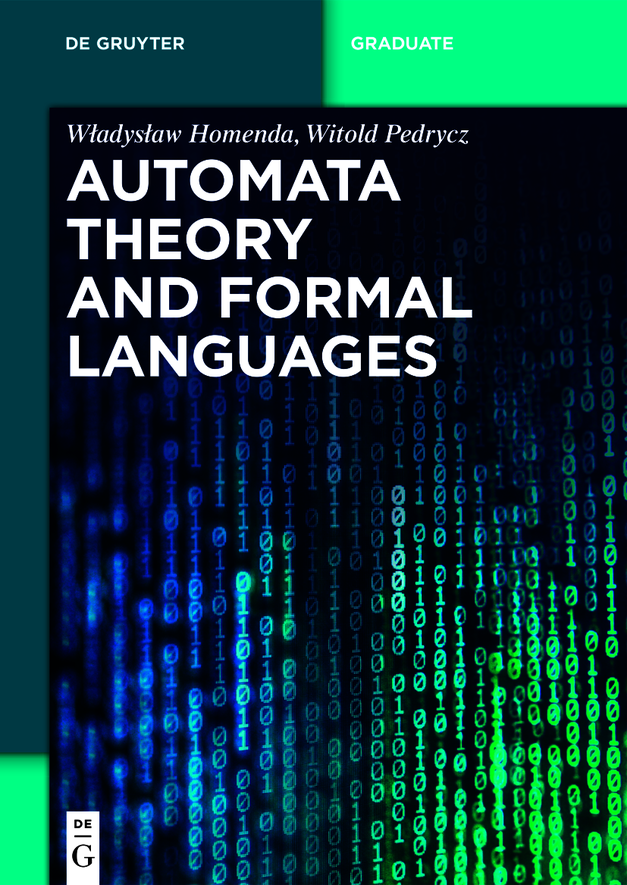
De Gruyter Textbook
ISBN 9783110752274
e-ISBN (PDF) 9783110752304
e-ISBN (EPUB) 9783110752311
Bibliographic information published by the Deutsche Nationalbibliothek
The Deutsche Nationalbibliothek lists this publication in the Deutsche Nationalbibliografie; detailed bibliographic data are available on the Internet at http://dnb.dnb.de.
2022 Walter de Gruyter GmbH, Berlin/Boston
This chapter offers all required prerequisites and elaborates on the notation used throughout the book. As such, the content presented here becomes helpful in the systematic exposure of the material covered in the consecutive chapters.
Finite sets include a finite number of members. The empty set, that is, the set which includes no members, is also finite. The empty set is denoted by . Infinite sets include infinitely many members. Infinite sets are countable or uncountable.
We say that a set is countable if and only if its members could be arranged in a particular sequence. In other words, a set is countable if and only if we can enumerate (list) its members assigning natural numbers to them. Such an arrangement guarantees to find a number assigned to any of its members. Of course, finite sets are also countable. Thus the conclusion that any subset of a countable set is countable becomes obvious.
A set is uncountable if and only if there is no enumeration of its members. Any set including an uncountable subset is uncountable.
Here are some important sets of numbers:
P={2,3,5,7,11,13,17,} the set of prime numbers;
N={0,1,2,3,4,5,6,7,8,} the set of natural numbers;
Z={,3,2,1,0,1,2,3,} the set of integer numbers;
Q={a/b:a,bZ,b0} the set of rational numbers, which are fractions of integers with nonzero denominator;
R the set of real numbers. It includes rational numbers as well as irrational numbers as, for instance, ,e,2 .
Note that all but the last set of numbers are countable. The last one is uncountable. The following notes concerning the above sets show arrangements of their elements in sequences, that is, justify countability of these sets:
comparing Example , it is straightforward that the set of prime numbers and the set of natural numbers are countable;
the following enumeration of the set of integer numbers Z={0,1,1,2,2,3,3,} shows its countability;
an intuitive depiction of Cantor enumeration of the set of pairs of natural numbers is shown in . This intuition can be explicitly expressed by the formula (x,y)=(x+y)(x+y+1)/2+x , where (x,y) is an enumerated pair of natural numbers.
Table 1.1 Cantor enumeration of the set of pairs (x,y) of integer numbers. An intuitive depiction is shown below where x enumerates rows and y columns.
| 0 | 1 | 2 | 3 | 4 | 5 | |
| 0 | 0 | 1 | 3 | 6 | 10 | 15 |
| 1 | 2 | 4 | 7 | 11 | 16 | 22 |
| 2 | 5 | 8 | 12 | 17 | 23 | |
| 3 | 9 | 13 | 18 | 24 | ||
| 4 | 14 | 19 | 25 | 24 | ||
| 5 | 20 | 26 |
The Cantor enumeration of pairs of natural numbers reveals some interesting characteristics. We note that any rational number can be represented as a fraction of two integer numbers. Any nonnegative fraction is formed by taking a columns label as the numerator and treating a label of a row (except the first one) as its denominator. In this enumeration, any fraction appears once in irreducible form and infinitely many times in reducible form. Cantor enumeration of pairs of natural numbers could be adapted to an enumeration of nonnegative rational numbers by skipping reducible fractions. On the other hand, since the set of rational numbers is a (proper) subset of pairs of natural numbers, the countability of the set of non-negative rational numbers is a direct result of the countability of the set of pairs of natural numbers. Finally, we can apply the way of enumeration of the set of integer numbers to all rational numbers.
Let us consider the unit interval of real numbers. Any member of this set could be represented in the form of infinite expansion. Assume that all real numbers are arranged in the following sequence:
The following real number of the unit interval does not appear in this sequence, where b is the binary digit opposite to the digit b, that is, b=0 if and only if b0 :
Therefore, the assumption that all real numbers of the unit interval could be arranged in a sequence is false.
Let us consider the set ={0,1} of binary digits and the set ={0,1} of all binary strings of finite length. Binary strings can be put (arranged) in a so called canonical order, that is,
shorter strings precede longer ones and
given two strings of the same length, this string comes first, which have 0 at the leftmost position that is different in both strings.
Denoting the empty string (of length 0) by we get the following sequence of binary strings in canonical order:
Canonical order of binary strings creates enumeration, which assigns natural numbers to consecutive strings of this family. The existence of such enumeration directly proves that the set of binary strings is countable.
Elementary operations performed on sets are: taking subset, union, intersection, complement of a subset and Cartesian product.
Let us recall that Cartesian product X1X2Xn of sets X1,X2,,Xn is the set of so called n-tuples {(x1,x2,,xn):x1X1,x2X2,,xnXn} .
Note that finite sets and countable sets are closed under the above operations. For instance, the result of the complement of a subset of a countable set is also countable.
Relations play a fundamental role in this book. They are exploited in interpretation of key ideas and concepts such as graphs, grammars, productions and derivations in grammars, transitions and computations of automata and machines. Relations are summoned up in this section while more specific relations concerning concepts covered in the book are brought up and discussed in consecutive sections.
Multiplace relations are also called multidimensional relations or n-ary relations. A relation is a subset of a given set of objects, usually a subset of the Cartesian product of a number of sets. In this book, relations are exclusively identified with Cartesian products of a number of nonempty sets. Elements of a relation are called tuples (or n-tuples in the case of elements of the Cartesian product composed of n sets). In particular, the n-tuples are referred to as follows: single (1-tuple), pair (2-tuple), triple, quadruple, quintuple, sextuple, etc. A multiplace relation defined in the Cartesian product of n sets is named an n-place relation or n-ary relation.
Any subset R of the Cartesian product X1X2Xn of nonempty sets X1,X2,,Xn , RX1X2Xn , is an
Font size:
Interval:
Bookmark:
Similar books «Automata Theory and Formal Languages»
Look at similar books to Automata Theory and Formal Languages. We have selected literature similar in name and meaning in the hope of providing readers with more options to find new, interesting, not yet read works.
Discussion, reviews of the book Automata Theory and Formal Languages and just readers' own opinions. Leave your comments, write what you think about the work, its meaning or the main characters. Specify what exactly you liked and what you didn't like, and why you think so.

